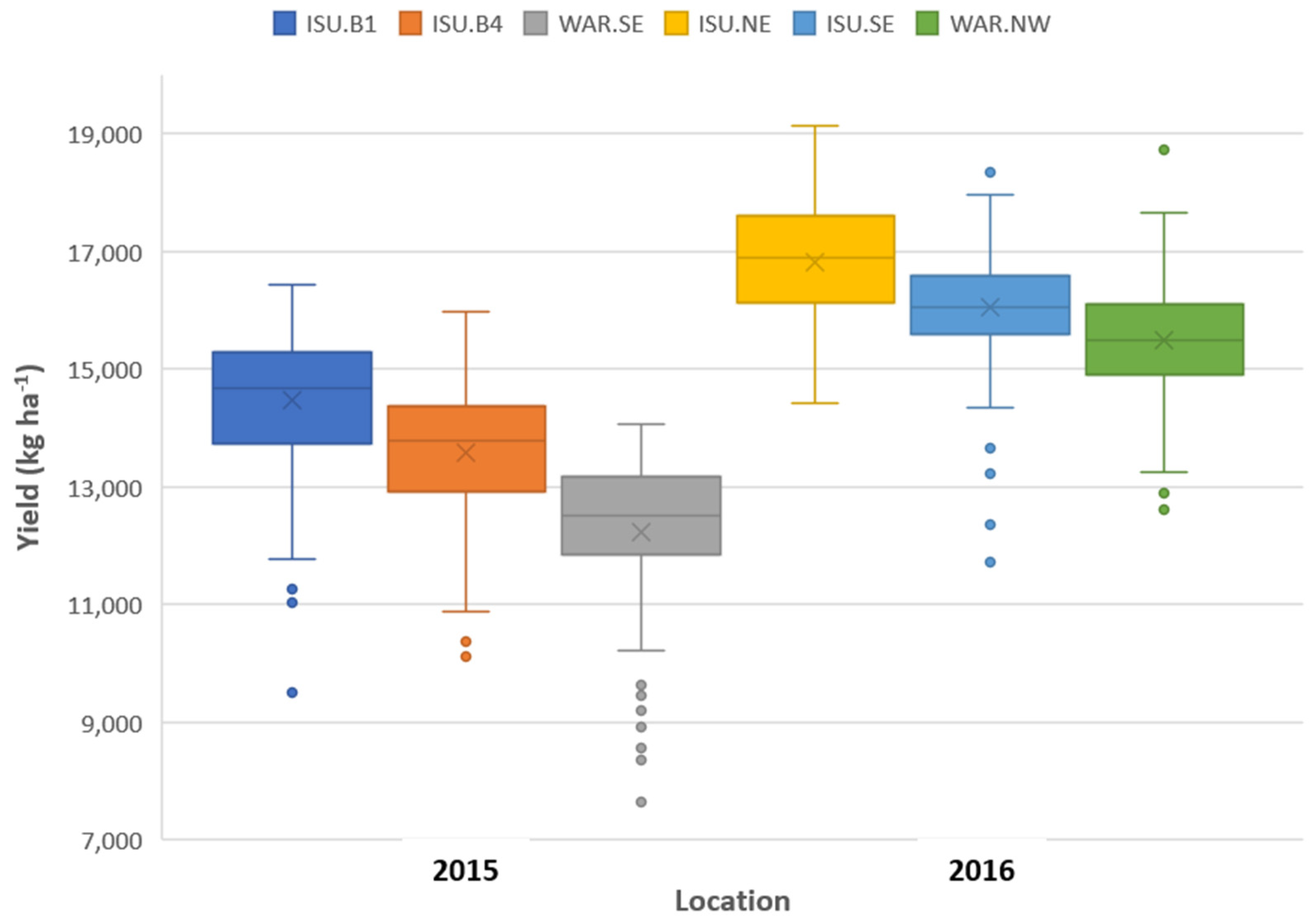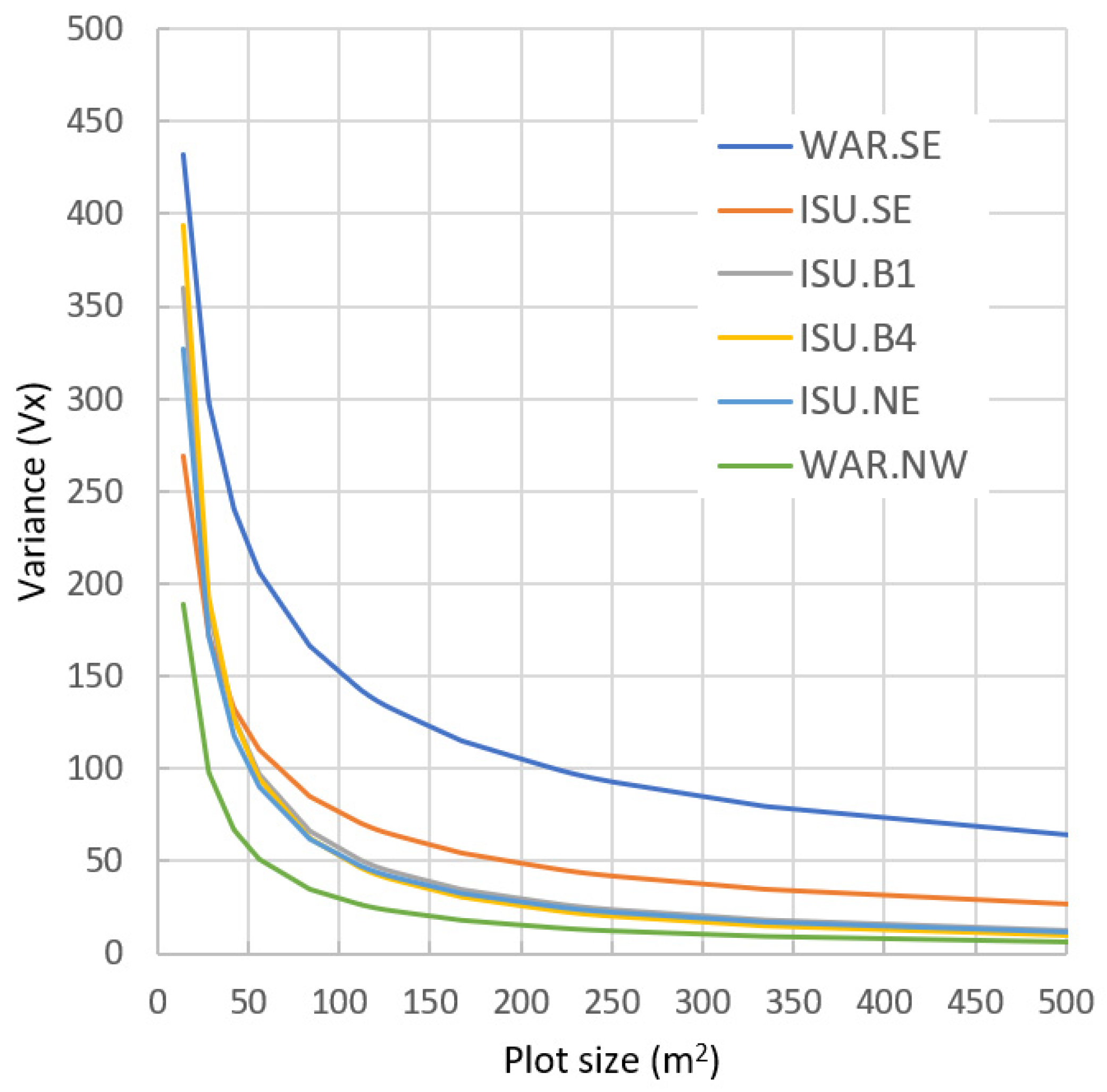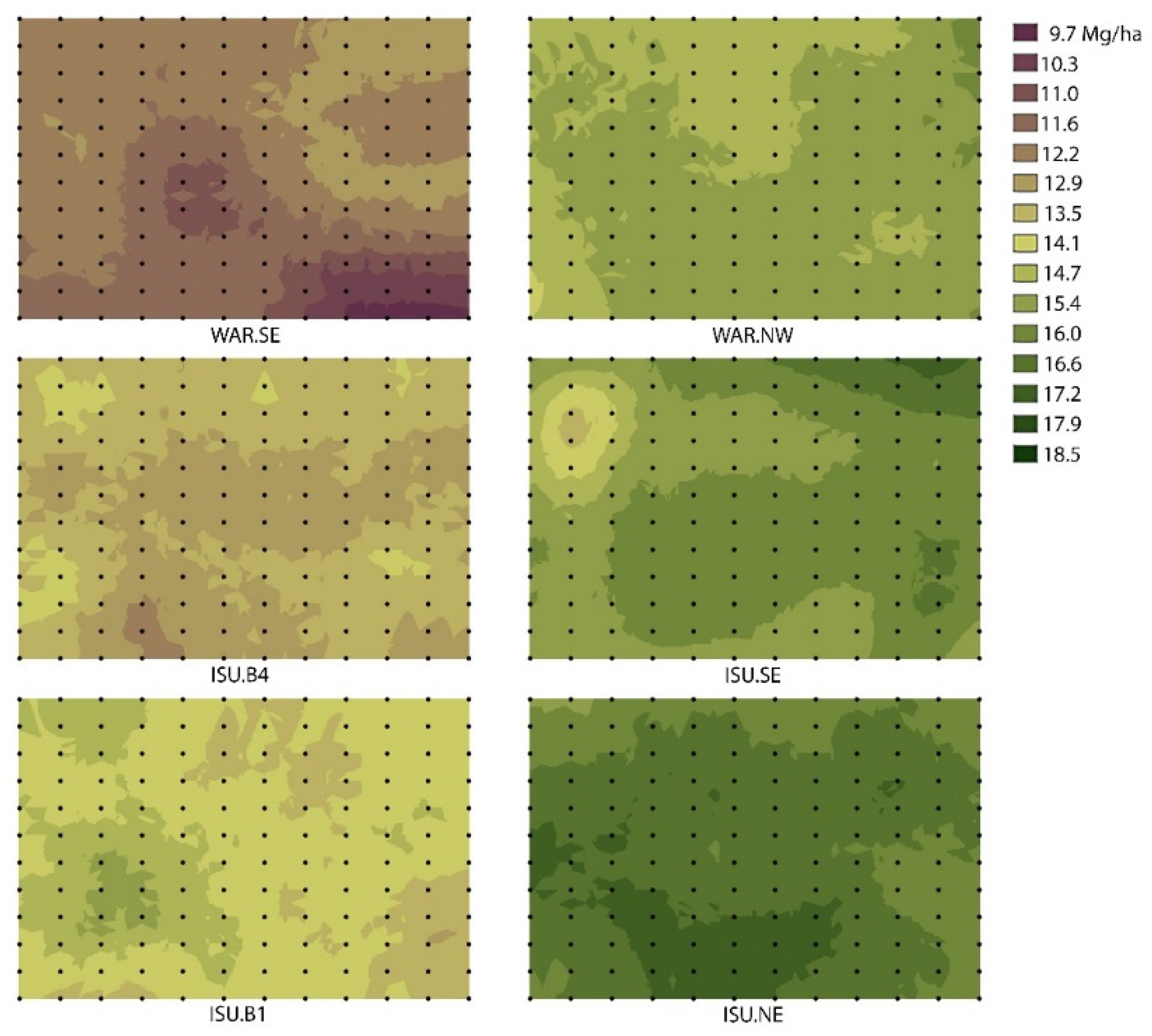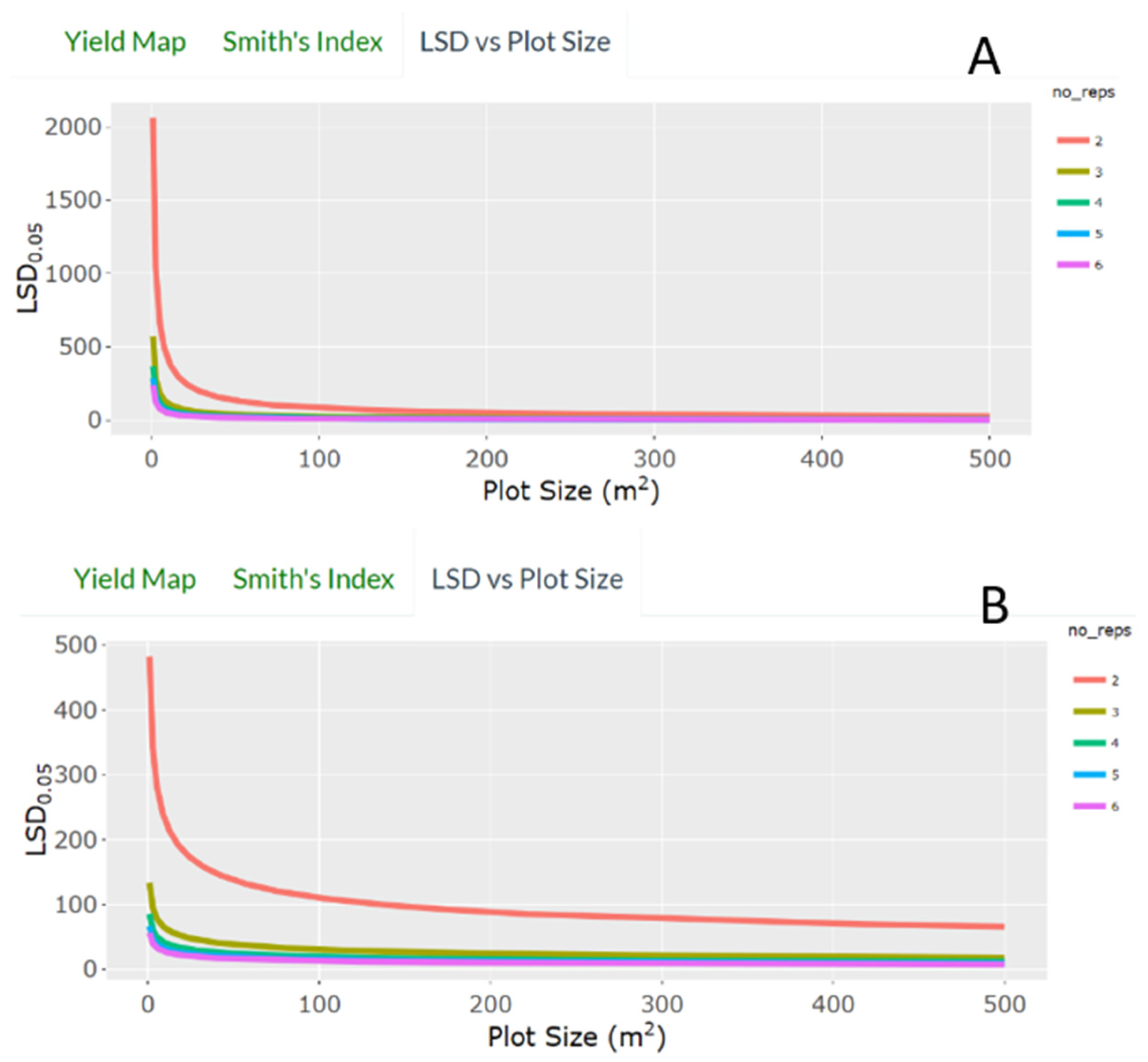Automating Uniformity Trials to Optimize Precision of Agronomic Field Trials
Abstract
:1. Introduction
2. Materials and Methods
2.1. Site Characteristics and Trial Execution
2.2. Uniformity-Trial Web Application
3. Results
3.1. Uniformity Trials
3.2. Uniformity-Trial Data Automation
4. Discussion
5. Conclusions
Supplementary Materials
Author Contributions
Funding
Conflicts of Interest
References
- Casler, M.D. Fundamentals of experimental design: Guidelines for designing successful experiments. Agron. J. 2015, 107, 692–705. [Google Scholar] [CrossRef] [Green Version]
- Steel, R.G.D.; Torrie, J.H.; Dickey, D.A. Principles and Procedures of Statistics: A Biometrical Approach, 3rd ed.; McGraw-Hill, Inc.: New York, NY, USA, 1997. [Google Scholar]
- Casler, M.D. Finding hidden treasure: A 28-year case study for optimizing experimental designs. Commun. Biometry Crop Sci. 2013, 8, 23–38. [Google Scholar]
- Sripathi, R.; Conaghan, P.; Grogan, D.; Casler, M.D. Field design factors affecting the precision of ryegrass forage yield estimation. Agron. J. 2017, 109, 858–869. [Google Scholar] [CrossRef]
- Lin, C.S.; Binns, M.R. Working rules for determining the plot size and numbers of plots per block in field experiments. J. Agric. Sci. 1984, 103, 11–15. [Google Scholar] [CrossRef]
- Smith, H.F. An empirical law describing heterogeneity in the yields of agricultural crops. J. Agric. Sci. 1938, 28, 1–23. [Google Scholar] [CrossRef]
- Petersen, R.G. Agricultural Experimentation: Design and Analysis; Marcel Dekker, Inc.: New York, NY, USA, 1994. [Google Scholar]
- Zhang, R.; Warrick, A.W.; Myers, D.E. Heterogeneity, plot shape effect and optimum plot size. Geoderma 1994, 62, 183–197. [Google Scholar] [CrossRef]
- Arny, A.C. Border effects and ways of avoiding it. J. Am. Soc. Agron. 1922, 14, 266–278. [Google Scholar] [CrossRef]
- Boerma, H.R.; Marchant, W.H.; Parker, M.B. Response of soybeans in maturity groups V, VI, VII, and VIII to end-trimming. Agron. J. 1976, 68, 723–725. [Google Scholar] [CrossRef]
- Holman, E.M.; Bednarz, C.W. Alley effect on several cotton cultivars in small-plot research. Commun. Soil Sci. Plant Anal. 2001, 32, 119–126. [Google Scholar] [CrossRef]
- Probst, A.H. Border effect in soybean nursery plots. J. Am. Soc. Agron. 1943, 35, 662–666. [Google Scholar] [CrossRef]
- Gomez, K.A.; Gomez, A.A. Statistical Procedures for Agricultural Research; John Wiley & Sons: New York, NY, USA, 1976. [Google Scholar]
- Day, J.W. The relation of size, shape, and number of replications of plots to probable error in field experiments. J. Am. Soc. Agron. 1920, 12, 100–106. [Google Scholar] [CrossRef] [Green Version]
- Hallauer, A.R. Estimation of soil variability and convenient plot size from corn trials. Agron. J. 1964, 56, 493–499. [Google Scholar] [CrossRef]
- Wuest, S.B.; Miller, B.C.; Alldredge, J.R.; Guy, S.O.; Karow, R.S.; Veseth, R.J.; Wysocki, D.J. Increasing plot length reduces experimental error of on-farm tests. J. Prod. Agric. 1994, 7, 211–215. [Google Scholar] [CrossRef]
- Chaves, L.J.; de Miranda Filho, J.B. Plot size for progeny selection in maize (Zea mays L.). Theor. Appl. Genetics 1992, 84, 963–970. [Google Scholar] [CrossRef] [PubMed]
- Masood, M.A.; Javed, M.A. Variability in field experiments in maize crop in Pakistan. Pak. J. Agric. Sci. Faisalabad. 2003, 40, 207–209. [Google Scholar]
- de Mendiburu, F. Agricolae: Statistical Procedures for Agricultural Research. R Package Version 1.3-2. 2020. Available online: https://CRAN.R-project.org/package=agricolae (accessed on 18 June 2021).
- R Core Team. R: A Language and Environment for Statistical Computing; R Foundation for Statistical Computing: Vienna, Austria, 2019; Available online: https://www.R-project.org/ (accessed on 18 June 2021).
- Chang, W.; Cheng, J.; Allaire, J.J.; Xie, Y.; McPherson, J. Shiny: Web Application. Framework for R. R Package Version 1.4.0. 2019. Available online: https://CRAN.R-project.org/package=shiny (accessed on 18 June 2021).
- Wickham, H. ggplot2: Elegant Graphics for Data Analysis; Springer: New York, NY, USA, 2016. [Google Scholar]
- Sievert, C. Interactive Web-Based Data Visualization with R, Plotly, and Shiny; Chapman and Hall/CRC: Boca Raton, FL, USA, 2020. [Google Scholar]
- Siao, F. Uniformity trials with cotton. J. Am. Soc. Agron. 1935, 27, 974–979. [Google Scholar] [CrossRef]
- Jones, M.; Woodward, R.; Stoller, J. Increasing precision in agronomic field trials using latin square designs. Agron. J. 2015, 107, 20–24. [Google Scholar] [CrossRef] [Green Version]
- Vincelli, P.; Lee, C. Influence of open alleys in field trial assessing yield effects from fungicides in corn. Plant Dis. 2015, 99, 263–266. [Google Scholar] [CrossRef]
- Tedford, E.C.; Kriss, A.B.; Geater, C.; Saini, M.; Battles, B.; Smelser, R.B.; Fithian, W.A. Plot size can influence yield benefits from fungicides on corn. Crop Prot. 2017, 91, 66–73. [Google Scholar] [CrossRef] [Green Version]
- Kandel, Y.R.; Hunt, C.L.; Kyveryga, P.M.; Mueller, T.A.; Mueller, D.S. Differences in small plot and on-farm trials for yield responses to foliar fungicide in soybean. Plant Dis. 2018, 102, 140–145. [Google Scholar] [CrossRef] [Green Version]
- Van Es, H.M.; Gomes, C.P.; Sellman, M.; van Es, C.L. Spatially-balanced complete block designs for field experiments. Geoderma 2007, 140, 346–352. [Google Scholar] [CrossRef]







| Trial | 2015 | 2016 | ||||
|---|---|---|---|---|---|---|
| Location | Boone, IA, USA | Boone, IA, USA | River Falls, WI, USA | Boone, IA, USA | Boone, IA, USA | River Falls, WI, USA |
| Field name | ISU B1 | ISU B4/B5 | Wahr SE | ISU NE | ISU SE | Wahr NW |
| Soil type(s) | Nicollet | Nicollet | Pillot | Canisteo Harps | Canisteo Clarion | Pillot |
| Previous crop | Corn | Corn | Corn | Soybean | Corn | Soybean |
| Hybrid planted | Channel 1 211–97 | Channel 211–97 | Croplan 2 2845SS | Pioneer 3 P0969AM | Pioneer P1197AMXT | Croplan 4099 |
| Planting date | 1 May | 2 May | 13 May | 13 May | 18 May | 5 May |
| Harvest date | 15 October | 15 October | 11 November | 24 October | 24 October | 31 October |
| Planting density (plant ha−1) | 79,073 | 79,073 | 74,131 | 75,614 | 78,826 | 79,073 |
| Preplanting fertilizer | 168 kg N ha−1 anhydrous ammonia | 168 kg N ha−1 anhydrous ammonia | 150 kg N ha−1 anhydrous ammonia | 168 kg N ha−1 anhydrous ammonia | 168 kg N ha−1 anhydrous ammonia | 150 kg N ha−1 anhydrous ammonia |
| Side-dress fertilizer | 64 kg N ha−1 urea–ammonium nitrate | 86 kg N ha−1 urea–ammonium nitrate | 67 kg N ha−1 urea–ammonium nitrate | - | - | 67 kg N ha−1 urea–ammonium nitrate |
| Field | b | ln(V) | ||
|---|---|---|---|---|
| ISU.B1 | 0.946 | a | 8.376 | a |
| ISU.B4 | 1.026 | a | 8.677 | a |
| WAR.SE | 0.532 | b | 7.470 | b |
| ISU.NE | 0.926 | a | 8.225 | a |
| ISU.SE | 0.642 | b | 7.282 | b |
| WAR.NW | 0.940 | a | 7.713 | a |
| SE | 0.062 | 0.291 |
Publisher’s Note: MDPI stays neutral with regard to jurisdictional claims in published maps and institutional affiliations. |
© 2021 by the authors. Licensee MDPI, Basel, Switzerland. This article is an open access article distributed under the terms and conditions of the Creative Commons Attribution (CC BY) license (https://creativecommons.org/licenses/by/4.0/).
Share and Cite
Jones, M.; Harbur, M.; Moore, K.J. Automating Uniformity Trials to Optimize Precision of Agronomic Field Trials. Agronomy 2021, 11, 1254. https://doi.org/10.3390/agronomy11061254
Jones M, Harbur M, Moore KJ. Automating Uniformity Trials to Optimize Precision of Agronomic Field Trials. Agronomy. 2021; 11(6):1254. https://doi.org/10.3390/agronomy11061254
Chicago/Turabian StyleJones, Marcus, Marin Harbur, and Ken J. Moore. 2021. "Automating Uniformity Trials to Optimize Precision of Agronomic Field Trials" Agronomy 11, no. 6: 1254. https://doi.org/10.3390/agronomy11061254
APA StyleJones, M., Harbur, M., & Moore, K. J. (2021). Automating Uniformity Trials to Optimize Precision of Agronomic Field Trials. Agronomy, 11(6), 1254. https://doi.org/10.3390/agronomy11061254







